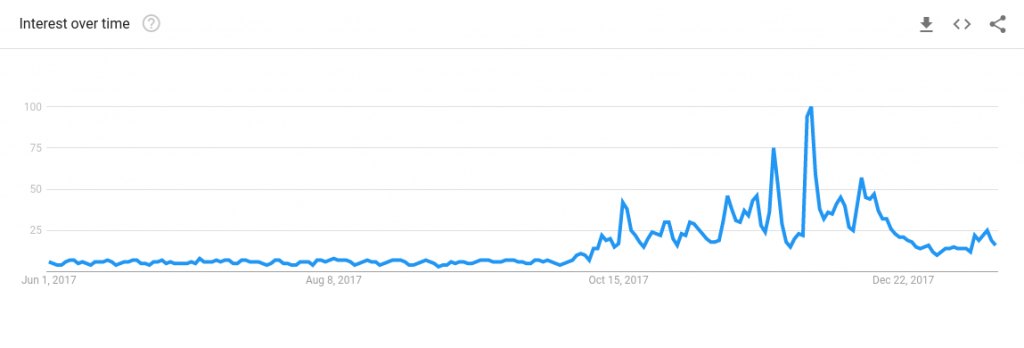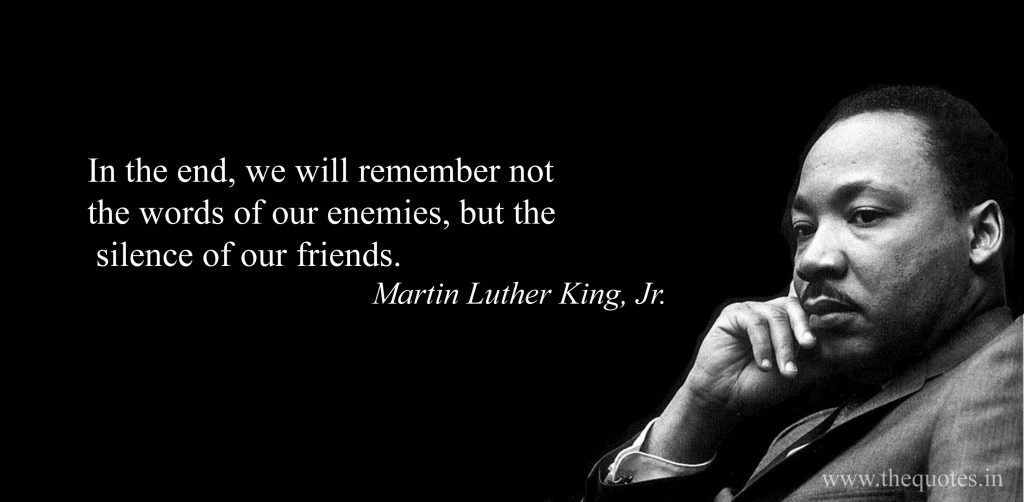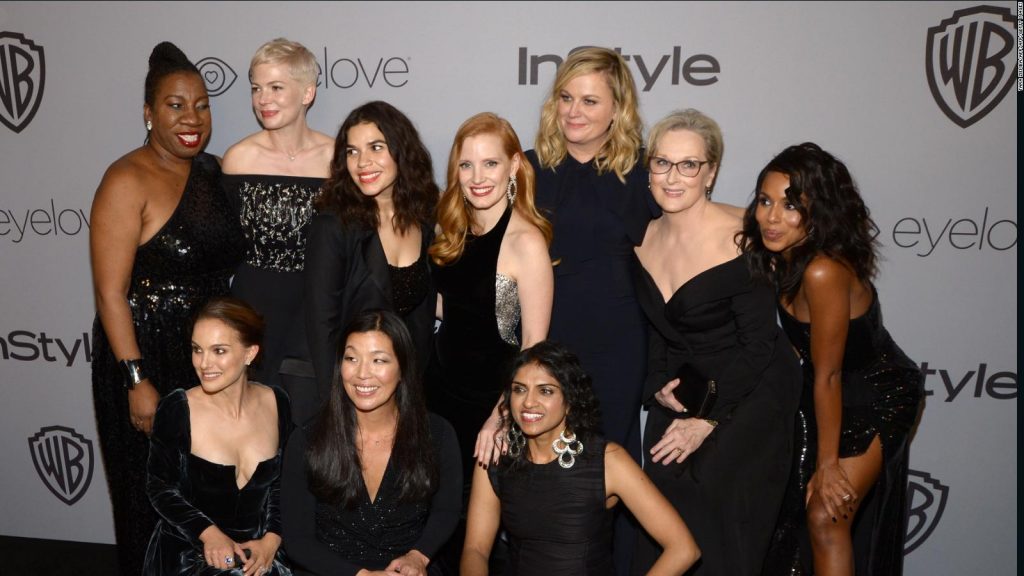
“We need more girls and women telling their stories.”
“We need more women to stand up in solidarity and sisterhood.”
“We need more women in leadership.”
“We need more women to take action and demand change.”
These statements are all true.
But there’s a critical component that has been omitted, a key player missing in the conversation.
Men.
I’ll explain.
In 2017, the Silence Breakers kicked down the door on sexual harassment and started a powerful conversation. The #MeToo movement gave voice to stories of abuse and brought the women behind the stories out from the shadows and into the spotlight.
Women are standing up and demanding change.
But is it enough?
Will women speaking up and demanding change eliminate, or at least diminish the sexual harassment plaguing our society?
The chart below shows ‘sexual harassment’ trending in Google. We see spikes in activity when new accusations surface. It fades from there. People stop talking about it.
 The #MeToo movement has sparked public interest in the topic.
The #MeToo movement has sparked public interest in the topic.

Above, we see the Google trend for the ‘Me Too movement.’
The spikes in engagement happened when Alyssa Milano tweeted the “Me Too” hashtag inspired By Tarana Burke and the day of the Golden Globes. After those two public displays of activism, talk about the movement online declines.
With all the stats showing the amount of woman being sexually assaulted or harassed, the #MeToo movement should be raising every day, or at least stay trending.
But it’s not.
So, how do we avoid having a topic of such importance “trend” or become a thing of the past that was talked about?
This topic should be trending almost every day, with more individuals breaking the silence, companies changing policies and implementing consequences, and powerful men standing on the right side and condemning other men…
Women alone standing up and demanding change alone is not enough to keep the momentum up.
Here’s why:
Sexual harassment and violence against women isn’t passively happening to women.
There are active agents inflicting the abuse.
Those active agents are predominantly men.
Yet, we don’t talk about men. The conversation is focused on women.
“We talk about how many women were raped last year, not about how many men raped women. We talk about how many girls in a school district were harassed last year, not about how many boys harassed girls. We talk about how many teenage girls in the state of Vermont got pregnant last year, rather than how many men and boys impregnated teenage girls.”
“So you can see how the use of the passive voice has a political effect. [It] shifts the focus off of men and boys and onto girls and women. Even the term ‘violence against women’ is problematic. It’s a passive construction; there’s no active agent in the sentence. It’s a bad thing that happens to women, but when you look at that term, “violence against women,’ nobody is doing it to them. It just happens to them… Men aren’t even a part of it!” – Jackson Katz
We’re having the wrong conversation.
In Jackson Katz TedTalk, he argues that violence against women isn’t a women’s issue at all.
It’s a men’s issue.
Viewing sexual harassment and violence as a ‘women’s issue’ effectively alienates men from the conversation and leaves it up to women to figure out.
Women cannot fix a problem they aren’t primarily the perpetrators of.
At least, not alone they can’t.
Instead of focusing on women’s speech and behavior, we need to take a hard look at the culture that produces men who abuse women.
Then, we can ask important questions, like:
“Why do men speak about women in degrading and sexist ways?”
“Why do men abuse women—verbally, physically, psychologically, and sexually?”
Then, we can start to think of how we can do things differently. How we can change practices, change the socialization of boys and the definitions of manhood that lead to the current outcomes we see.
Men at the Golden Globes 2018
What we saw on the red carpet this year is a perfect example of how we’re missing the mark with men in the movement.
We saw a whole lot of women speaking up, holding hands, and standing together as sisters.
But what about men?
They were there, of course. But it was as though a message had been broadcast across the red carpet: jump on board, or get the hell out of the way.
‘Jump on board’ seemed to entail sporting black suits and Time’s Up pins, and stepping aside and shutting up as women stepped forward and spoke up.
The only man who directly referenced the “elephant not in the room” was Seth Meyers, when he joked about Hollywood big shots recently taken down by the media, addressing Harvey Weinstein and Kevin Spacey by name.
The truth is uncomfortable.
We saw this notion come alive as Meyers’ jokes were met with awkward laughs and cautious celebration from the crowd.

Ignoring the truth, or choosing to only focus on half of it, will only get us half way there.
We have to invite the uncomfortable in, let it sit in the room and breathe as the living entity that it is, so we can start to break it down and diminish its harmful effects on society, and the women who make up half of that society.
Why did most men stay silent at the Golden Globes?
Why do men continue to remain silent amidst daily accusations, across industries and institutions in our society?
There are several reasons man stay silent on the topic.
- Sexual harassment and violence against women is perceived as a ‘women’s issue’
- Fear of facing accusations themselves
- They don’t know what to say
- Fear of saying the wrong thing
Women standing up and giving voice to their stories is critical to the movement. Men standing up and helping make sure that voice gets heard is critical to change.
What Is Men’s Role in the Movement?
Jackson Katz teaches an approach that is an excellent first step: The Bystander Approach.
People who are not directly involved in actions of abuse—anyone who is not a perpetrator or victim in any given situation. This includes friends, teammates, colleagues, coworkers, and family members who have relationships with people who might be in a situation of abuse.
As Bystanders, What Can We Do?
How do we speak up? How do we challenge our friends? How do we NOT remain silent in the face of abuse?
For men and male culture, the goal is to get men who are not abusive to challenge men who are.
That doesn’t mean stepping into an instance of physical abuse to stop someone from getting hit.
Let’s look at an example:
If you’re a man and you’re in an all-male setting, watching a football game or playing poker, and another guy says something sexist or degrading about women, instead of laughing along or pretending you didn’t hear it, we need men to say, “Hey, that’s not funny. That could be my sister or friend you’re talking about. Could you joke about something else? I don’t appreciate that kind of talk.”
Staying silent is a form of consent and complicity.

If we can get to the place where men who act out in sexist and harassing ways towards women will lose status as a result of it, only then will we see a radical diminution of the abuse.
This might sound simple enough. But there are pressures on men in a male culture that makes it difficult for them to challenge each other.
We need to hold men in positions of power and leadership accountable.
They must lead by example so change can cascade down from the top.
This is precisely what we didn’t see in Hollywood the night of the Golden Globes. It’s what we continue to lack in our schools, sports, politics, and leadership across industries.
Yet these are the exact institutions and settings where our young boys and girls are being raised to grow into individuals pitted against each other, instead of working together side by side.
There is no doubt that there are a lot of men who genuinely care about this issue.
But caring isn’t enough.
We need more men with the courage and moral integrity to break the complicit silence and challenge each other so they can stand with women, not against them.
Women have broken the silence.
Now, we need men to break the silence.







